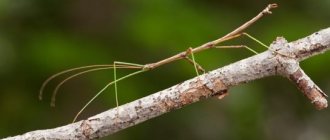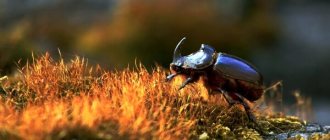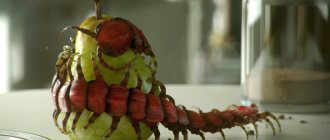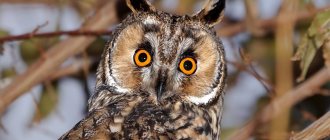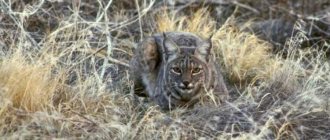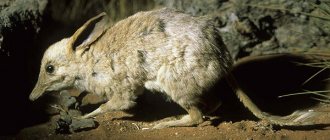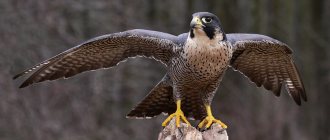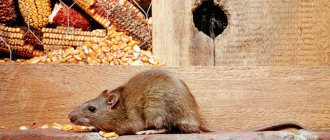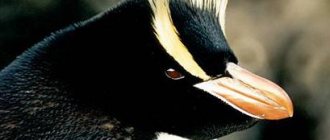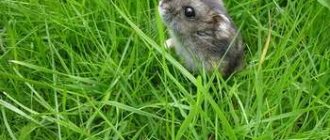Where do different types of scorpions live and what do they eat? Imperial
In his family he is considered a real giant. The length of its body can reach 15 cm, and taking into account the tail and claws, it exceeds twenty. Imperial scorpions are painted in a rich black color with a dark green tint. It has wide and thick claws with which it captures and holds prey. Under natural conditions it lives up to thirteen years. This species lives in the tropical forests of West Africa.
These are the oldest known arthropods on the planet
Scorpions have lived on Earth for a very long time and are one of the first animals to adapt to life on land. Fossils of scorpions have been found in strata of the Paleozoic era, many of them looking very little different from the descendants that crawl around the Earth today. This means that if you hopped into a time machine and traveled back in time 430 million years, you would immediately recognize scorpions. Currently, paleontologists have described about 130 extinct species of scorpions. There are fossil records of sea scorpions up to 1 meter long!
Photo: Getty Images
Yellow scorpion (leurus)
It belongs to the genus Leiurus quinquestriatus, which means "deadly pursuer". Scorpions of this subspecies are considered to be a variety of the class Androctonus australis (andros - “man”, ctonus - “killer”). The Latin name warns of the danger of this insect. This species lives in Turkey, Arabia, and North Africa. Its bite is very painful, and the venom contains strong neurotoxins.
A completely healthy person has a chance to recover from poisoning. This scorpio is much more dangerous for people with poor health and children. Often, after a yellow scorpion sting, anaphylactic shock occurs - a serious allergic reaction that leads to suffocation and even death.
Small insects (cockroaches, spiders, zoobass) are what the leurus scorpion feeds on, although experts say that it is more picky in food than many of its relatives.
Parabuthus transvaalicus
The African Transvaal fat-tailed scorpion, or simply the dark scorpion, lives in the southern part of the African continent, and adults grow up to 11 cm.
It has a menacing dark brown or black color, which is why it got its second name. The claws of this scorpion are thin, but the tail part is thickened.
The venom of Parabuthus transvaalicus is very toxic, and what is most dangerous is that the scorpion can inject venom not only through a bite, but is also capable of shooting a stream of venom up to a distance of one meter immediately before attacking.
9
Tree scorpion
This species has several varieties, which differ mainly in color. It may be monochrome (various shades of yellow) or include black spots or stripes. Without a tail, the body length of adult spiders reaches seven and a half centimeters.
The claws of tree scorpions are long and thin, and the thickness of the tail is no more than 5 mm. This species is common in the deserts of the USA, Mexico, and forests of North Africa. What do scorpions eat in the desert? Juveniles prefer small insects. The prey of adult spiders is small invertebrates, phalanges, spiders, and weaker scorpions.
Desert hairy
Most people associate Scorpios with deserts and mountainous areas. It is in such arid places of southern California and the Arizona desert, where the scorpion called “Desert Hairy” (Hadrurus arizonensis) lives, that there are a lot of them. It has a contrasting color. Its back is dark brown, its claws are sandy yellow.
The legs and tail of the scorpion are covered with hairs, which characterizes this species. Together with claws and tail, this individual can reach 18 cm. It waits out the midday heat in a hole dug by itself or under stones. Their menu consists of beetles, cockroaches, small insects, and moths.
Variegated Scorpion
This species has a fairly wide range: from Turkey, Syria and the southern regions of Russia to Southern Mongolia, Northern China, and Afghanistan. Inhabits semi-deserts, deserts and foothills. Body length is about six centimeters, males are smaller than females. These spiders are colored yellow or yellow-brown. Sometimes there are individuals with transverse stripes. You are probably interested in what scorpions eat in the deserts of Russia. Their diet is small arthropods.
The venom of the motley scorpion is less dangerous for humans than other members of the family. A person stung by this spider experiences itching, pain and burning, and the bite site swells and turns red. Scientists believe that some components of this poison can be used in the treatment of malaria and arthritis.
Black fat-tailed
Another desert representative is called black androctonus (Androctonus crassicauda). It is found in large quantities in the United Arab Emirates. The places where the scorpion lives (you see a photo of it in the article) are located in deserts. Its dimensions can reach 12 cm. The color has all shades of black and more. Some of its representatives may be green-olive, brown with a reddish tint, or a combination color.
He sometimes lives next to a person, hiding in the cracks of houses and fences, and also far from him, in dug holes. It feeds on large insects or small vertebrate rodents. Its main difference is its large, massive tail.
General description of Scorpios
Externally, scorpions look terrifying: a cephalothorax that is wide in front and slightly tapering towards the tail, and two impressive claws, which are a tool for capturing and holding prey. Another pair of limbs became a vestige. It is located near the mouth and is the jaw organ - the mandible.
The spider's four pairs of legs are attached to the lower abdomen. They allow the scorpion to move quite quickly on sand in the desert or on mountainous rocky soils. The capsule segment, shaped like a pear, with glands that produce poison, is located at the last segment of the abdomen.
The scorpion's body is covered with a very durable chitinous shell. Perhaps it is for this reason that he has almost no enemies. Scorpios have very well developed vision. On the upper cephalothorax of spiders there can be from two to eight eyes (depending on the species). One pair of eyes is larger and is called the median pair. It is located in the middle of the cephalothorax. The rest are located at the front edge.
Reproduction and lifespan
The mating ritual includes mating and a mating dance. The male holds the female with his forelimbs and begins to lead her along. This joint movement can continue for hours.
During this strange round dance, the male releases a capsule with seminal fluid (spermatophore). The female, following the male, comes into contact with the spermatophore. It enters the female's genitals, located in the lower abdomen. Fertilization occurs.
Female scorpion with offspring
The end of the mating dance coincides with the end of the fertilization process. At this moment, it is important for the male to quickly leave, otherwise he will be eaten. The female's pregnancy lasts a long time: from several months to one and a half years. As a result, from 20 to 30 or more cubs are born. The newborns are born one by one and are placed on the mother's back.
The scorpion is an invertebrate animal , but it has an exoskeleton in the form of a shell. In newly born arthropods it is soft. After a few hours the shell hardens. Young scorpions leave their mother's back and begin to lead an independent life. The first threat that they encounter in their life is their own mother. She can eat her offspring.
One of the important stages in the life of a Scorpio is molting. The age of young arthropods is measured by the number of molts. In order to become adults, young scorpions need to survive 5-7 molts.
The exoskeleton splits, the scorpion crawls out of the old shell, remaining soft and defenseless until the new armor completely hardens. Scorpions live long. From 2 to 10 years. Under favorable conditions, this life threshold can be exceeded.
What does a scorpion eat in nature?
It should be noted that these arachnids feed only on live prey: grasshoppers and spiders, cockroaches and crickets, centipedes and insect larvae. It is a well-known fact that large scorpions often attack small lizards and mice. When hunting, scorpions move slowly, picking up the slightest vibrations in the soil and air to determine the size and position of their prey.
Scorpio does not attack larger prey. In case of danger, it takes a defensive position - tilts its tail forward and swings it. Among these arthropods, cases of cannibalism have been recorded, when one individual eats its weaker fellow.
The special structure of the digestive system allows the scorpion not to eat every day. It gets the required amount of moisture from its victims. These creatures can go without food for quite a long time. There are cases where arthropods starved for more than a year.
The need for water depends on the species of scorpions. For example, desert animals need moisture in very small quantities, but for the inhabitants of tropical rainforests it is extremely important.
You should know not only what a scorpion eats, but also how often it does it. Scorpios eat no more than twice a week.
Interesting Facts
Modern biology, in addition to describing the appearance of scorpions and their life activity, has a number of interesting facts concerning these animals. One of these is the immunity of arthropods to radiation (up to 1000 roentgens) . Thus, after a nuclear explosion on Earth, only scorpions can survive.
Scorpios eat only live food. They never share their prey with their relatives. Finding themselves together in a small enclosed space, individuals will kill each other for the opportunity to eat, but will not give up food. These creatures can survive without food for 1.5 to 2 years.
Scorpions are the first arthropods to emerge from water onto land. The length of aquatic fossil arthropods reached one meter. Due to the fact that scorpions are able to move perfectly along walls, they can easily climb into windows located on the 3rd or 4th floors.
Eating at home
Some exotic pet lovers have started keeping scorpions in their homes. They are kept in special terrariums, creating conditions as close as possible to natural ones. In addition to a comfortable “home,” it is important to properly organize his diet. To do this, you need to know what a scorpion eats at home. They all eat once every few days. Only very small, not yet formed arthropods need more frequent feeding.
Knowing what a scorpion eats in natural conditions, you need to take care of live food, which today can be bought at a pet store. Various types of insects are the basis of the scorpion's diet, although large individuals sometimes prefer to feast on a small mouse. Forage insects include: caterpillars and larvae, grasshoppers and crickets, zofobas beetles and cockroaches. Choose foods to feed that are familiar to scorpions in their natural environment.
They don't need vegetables: most Scorpios don't show any interest in them. It is quite difficult to find water in the desert, however, a scorpion needs it. Therefore, equip not only a small container with water in the terrarium, but also provide your pets with regular showers (using a spray bottle), because in natural conditions they quite often take walks in the rain.
Prepare only clean water for drinking. Your pet will ignore all other drinks (milk, juices). If you already know what scorpions eat, then you can easily create a diet for your pet living in a terrarium. Don't forget about feeding frequency. Scorpions should not be overfed, but it is also not recommended to starve them, since in this case several individuals living in the same terrarium will begin to eat each other.
The complexities of science
When identifying the most dangerous species, one cannot rely on statistical data, since individual species of this family live in places with different population densities, so even the most poisonous representatives may simply have fewer contacts with humans.
For a long time, representatives of the black scorpion order were considered the most poisonous. Most likely this was due to its outstanding size, since the length from head to tail is 23 cm. It is quite difficult not to notice such a monster, especially against the backdrop of yellow sand. Representatives of this order actually produce poison, and the pain syndrome when bitten is extremely high. Mortality is directly related to a person’s weight, so a child most likely will not make it to medical practice, but an adult will come to his senses after several hours of excruciating pain.
In fact, the most poisonous species turned out to be a more modest-sized species - the yellow or Israeli scorpion. In order to determine this, a large number of laboratory tests were carried out. At the first stages, proportional amounts of poison of different types were exposed to laboratory rodents: mice and rats. After receiving this data, the test subjects were changed to primates, which have body functions much closer to humans than rodents. According to the results of these experiments, the palm was firmly assigned to the yellow scorpion.
Scorpionism
The bite of this arthropod is scientifically called scorpionism. The most poisonous of the entire family stings a person almost without pain, since the tip of the tail on which the needle is located is quite thin. This process is accompanied only by a slight pricking sensation. The pain is not due to a violation of the integrity of the skin, but to the effect of the poison on the nerve endings.
Scientists have long studied what explains the high mortality rate after a human bite by a representative of this species. As it turned out, not only the composition of the poison is responsible for this, as it would be logical to assume, but also the method of its entry into the victim’s skin.
In order to capture this process, the laboratory used several high-speed cameras, which were able to slow down the footage, and the scientists, in turn, were able to examine in detail the trajectory of the tail strike at the moment of the attack. It turned out that the tail moves faster than that of any other species, namely at a speed of 130 cm/sec. At the same time, the poison enters the deep layers of the skin with lightning speed, therefore it spreads throughout the body faster than after contact with the sting of other types. After a clear blow from top to bottom, pain and swelling immediately appear.
What can save
The victim's chances also depend on whether first aid was provided correctly. Immediately after the poisonous toxin gets under the skin, you must apply a hot match to the wound. The fact is that the toxins of the poison quickly denature when exposed to high temperature and do not disperse throughout the body. Further rescue actions should be carried out by doctors.
The bitten area is pricked on all sides with a solution of novocaine, and atropine, dihydroergotoxin, etc. is injected intravenously. This is followed by several days, during which the patient is given droppers with medicine to remove toxins.
In France and Germany, they produce a special serum that is very effective after such a bite, but in remote deserts in first-aid posts or even small hospitals it is not always found. Scientists who study the life and physiology of representatives of this species in the wild prefer to bring such serum with them just in case.
Death or life
Even the most dangerous substance released from the sting of a yellow scorpion can be beneficial to humanity. A famous saying goes: “What doesn’t kill us makes us stronger.” In this case, a wise statement reflects the essence as closely as possible.
Doctors made an extract from the secretion of the most dangerous scorpion on earth in the form of a substance called chlorotoxin. They found that it is able to deliver anti-cancer genes to cancerous brain tumors, which are very aggressive and lead to rapid death of the patient. With the help of chlorotoxin, drugs are delivered to the target faster and more accurately than using all existing methods, which increases the effectiveness of treatment several times.
In addition, recent studies prove that the components of this poison are effective in treating diabetes mellitus and regulating the concentration of insulin in the blood. Therefore, it is likely that in the near future the extraction of this substance will become commercially profitable, and the first scorpion farms will appear.
